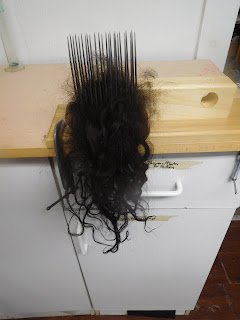Maryann wrote an article for an Icelandic magazine about the archaeological find and about her experience recreating the garment and we're hopeful that she can get either Interweave or Ply to publish it here in English.
Based on the textile fragment discovered in the dig (apparently a metal brooch helped preserve the textile enough that they could determine the fiber, dye, twist, and weave structure) she and another colleague reverse engineered it and then hand spun, dyed using woad, sett and then made the handwoven fabric in the same twill weave structure to completely recreate the jumper based on this tiny fragment!
What a wonderful spinning, kyeing and weaving project to take on and see thru from reverse engineering to re-creation! You'll have to keep your eye out for the article here in the US with pictures and so much more detail about their journey!
Unrelated to that Greenland textile recreation, Maryann (who has studied the historical textile traditions as part of an MA degree, I believe) has been handspinning a very fine 2 ply thread from the "tog" (see an earlier post about the difference between tog and thel in Icelandic fleece if you're interested). Apparently, this is what the Vikings used for thread. I purchased some from her to use in stitching the fish skins I bought in Iceland to felt bags I have planned with some Icelandic fleece. Here is a photo below showing the fine tog threads - three natural colors and the red is dyed with a berry.
The National Museum in Reykyavik is well worth a visit. We visited it on our previous visit to Iceland 4 years ago. The textile highlights for me were the nalbinding mittens and sock (the word they used for the technique describing these items technically translated into "needle coiling" and mentioned that it was a technique which predated knitting- which didn't come to Iceland until the 16th century). The museum also had a couple of crudely felted saddle blankets, pictured below the mittens. But there were other exhibits - non textile related - that were fascinating as well. And if you can't make it up north to the Blonduos Textile Museum, the Reykyavik museum had a few handknit mittens and shoe soles to show (but make an effort to get to the Textile Museum if you are going to Iceland!)
That sort of ends my photos and synopsis of the textile/sheep aspects of our trip that I thought any knitter, spinner or felter reading this might be interested in.
But of course, there are lots of other aspects of Iceland that we experienced, saw and enjoyed personally, so if anyone is planning a trip to Iceland and wants to ask me anything non-textile/sheep related about visiting the country shoot me an email. I'm happy to share what I have picked up during our last two trips there. From car rental issues to driving in Iceland, to riding, hiking or white water rafting there, food, literature, local brews - or even air bnbs to stay at. I can tell you what to look for or avoid based on our experience with these 2 trips, anyway.
It is an adventurous place....driving in the interior can be a bit nerve-racking as many roads you want to take are actually "tracks" criss-crossed by raging waters for which there are no bridges! I don't have a picture of my sisters having to ford rivers on the drive along a "track" to come pick me up after my hike in Landmannalauger (thankfully, after a glass of Vana Tallin and maybe a winning Penuchle hand, they forgave me!), but I snapped a shot of one such car crossing a river as I waited for my siblings to come get me!
As a side note...if any of you are runners, you might find this interesting. This Run the World lead car was for a group of runners from all over the world that were in Iceland running 100 miles of the most difficult/remote terrain. They wwere running the drive into Landmannalauger the day I was there - crazy people! We passed them at about 8:30 in the morning as they began the run and on our way into the area to hike for the day and I cheered the last one to arrive at about 5 p.m. that afternoon! It was a smart destination for them to run to since there was a great open hot spring to soak in at the base of the mountain we hiked (and where their run ended!).
Tho' I'm done using this blog to share the textile aspects of our trip, I may use this blog to record my experiences tanning fish skins and incorporating the fish skins from Iceland into some felt bags. I'm thinking it is better to write it here than in a paper notebook that I won't be able to find next year when I want to review what I did!
So if you're interested in seeing what happens with my experiments, check back in now and then to see if I have any results to show and tell!

















































